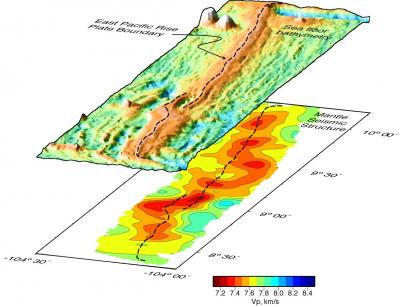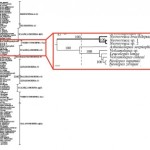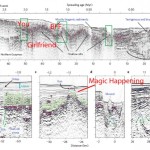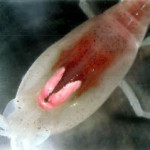
Perspective view of East Pacific Rise and the seismic velocity structure of the underlying mantle. Surprisingly, regions of magma storage in the mantle (shown as orange and red colors) are in many places not centered beneath the plate plate boundary. Courtesy Douglas Toomey
[Note from Craig: I have asked Kevin Zelnio, a graduate student with preeminent deep-sea biologist Chuck Fisher, to guest post. I am excited by the addition of Kevin as this should add breadth to DSN in the realm of chemosynthetic communities.]
Current thought about the formation of vents is that mantle upwells directly beneath a ridge crest and fuels tectonic processes and formation of hydrothermal vents. Differences in volcanic activity along a mid-ocean ridge segment might have been due to differences in magma volume, magma chamber size, or any other assortment of magma-related variables.
A paper published in this week’s issue of Nature, by Toomey et al. reports on a new discovery that may affect how deep-sea scientists search for new hydrothermal vents. Seismic data of mantle upwelling at a section of the East Pacific Rise (the boundary between the Pacific plate and the Cocos Plate) shows that the pattern of magma upwelling doesn’t exactly follow the ridge crest. In fact, the authors show that mantle upwelling is skewed 10 degrees counter-clockwise to the direction the plate is moving.

Toomey et al.’s paper suggests that most intense volcanic activity occurs where mantle upwelling intersects the ridge crest. It is at this intersection where hydrothermal fluids are warmer and the chance to discover new vents is the greatest. Using their technique to map out the volcanic “plumbing system” underneath mid-ocean ridges, and possibly even back-arc spreading centers, may aid vent researchers in site selection. Current site selection relies on temperature and salinity anomalies, though autonomous underwater vehicles are also proving to be successful in “sniffing” out potential vent sites. These techniques, used together, may prove to be the fastest and easiest way to search for new vent sites along unexplored mid-ocean ridge segments With limited resources and time, this geophysical “search image” may cut back on unnecessary bottom-time allowing scientists to spend their resources making more discoveries. This is another fantastic opportunity for geology and biology to come together and advance our understanding of the earth system and make new biological discoveries, such as new species or new chemosynthetic symbioses!
Share the post "From The Desk of Zelnio: New Geophysical Study May Point The Direction To New Vent Discoveries"






Kevin,
Excellent summary. Thanks!
Doug
Hi Doug,
It was my pleasure. Keep us posted at DSN on any new developments!
Kevin